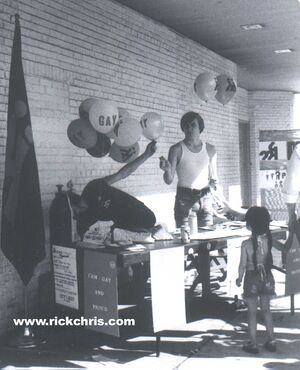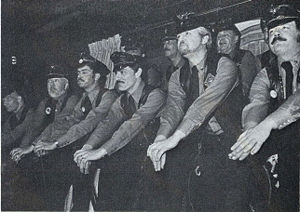Wis. LGBT History-- Organizations
ORGANIZATIONS in Wisconsin's LGBT History
Soon after the dust settled in Greenwich Village in 1969, gay civil rights organizations sprang up all over the country. Developments in Wisconsin were no different from what was happening elsewhere. In Milwaukee, both the Gay Liberation Organization and the Gay Liberation Front came into being in November 1970. The Gay Liberation Organization, fearing it would be confused with the more radical GLF, renamed itself the Gay People’s Union (GPU) in 1971.
Ever since, Wisconsin has had a wide range of organizations that enabled gays and lesbians to gather together to share common interests: in political action, health causes, sports, socializing, and other special interests.
The Wisconsin LGBT History Project website has just begun to document LGBT organizations, but aleady lists over 150 groups, many of which are documented by a web page and photos. The work continues.
A few of the groups that have helped shape Milwaukee and Wisconsin include:
Gay People Union
Milwaukee (1971-2000)
The Gay Peoples Union (or GPU) was founded as a social service agency dedicated to the needs of the gay community, and concurrently dedicated to educating the community at large about gays and lesbians.
The GPU was the "first" at many things: they opened the first gay/lesbian community center (the Farwell Community Center), the first gay health clinic (the GPU Venereal Disease Clinic, at one time offering testing 4 days a week- and which has since evolved into the BESTD Clinic and still operates 35 years later), a regular newsletter and membership-mailed magazine, hotline, and numereous other firsts.
The GPU was also the first organization in Milwaukee to host an event that had “Pride” appeal, with over 350 people attending the GPU Ball in 1974. Other dances and parties were hosted in the years that followed, and by 1981, a subgroup of the GPU, the Milwaukee Pride Week Committee, was coordinating activities of various organizations and also organized marches/ parades, rallies, and street festivals. (View the Milwaukee Pride Celebration TimeLine. Pride celebrations would eventually be organized by a more formal group, the Milw. Gay/Lesbian Pride Committee (MGLPC), and eventually PrideFest.)
The GPU largely went into decline after about 1985. Its magazine, the GPU News, for 10 years the best source of local gay/ lesbian news, was folded after the January 1981 issue after not enough volunteers were available to create it. During the 1990's and into the 2000's, the organization existed basically in name only.
Silver Star Motorcycle Club
Milwaukee (1973-1980)
The Silver Stars Motorcycle/ Leather Club was formed in June 1973 as a motorcycle club, and was largely associated with the Wreck Room bar.
In September 1975 a subsidiary of the Silver Star M.C. Inc. published "G Milwaukee", a publication addressing the need for people "wanting a local paper or magazine to get the news of social events, activities and local news out to the gay community", and welcoming "anything of interest... to the gay community". The first issue addressed venereal diseases; offered a guide on "How to 'Make It' with a Leather Man"; promoted a Childrens Christmas Drive; printed a letter from a newer member of Silver Stars M.C.-- and had a "guide" listing 12 bars and two bathhouses.
In the late 1970s a faction formed within the group, and in 1981 some of the members split off to form a rival motorcycle club, Castaways M.C.. Soon, the Silver Star group refused to allow dual memberships: that is, a member of Castways would not be allowed to also be a member in Silver Star.
Silver Star folded as an organization by the early 1980s.
Brady East STD/ BESTD Clinic
Milwaukee (1974-present)
The BESTD story is a long history of volunteers providing healthcare services to greater Milwaukee. In the early 1970's, a group of concerned and caring people responded to the rising incidences of sexually transmitted diseases in Milwaukee and the lack of sensitive, accessible resources. Their discussions and encouragement from the Milwaukee Health Department and the Wisconsin Division of Health resulted in the founding of the BESTD Clinic (then known as the Gay People's Union Venereal Disease Clinic - GPU VD Clinic) in October 1974.
Located initially in rented quarters on east St. Paul Avenue, and then on Farwell Avenue, the Brady East STD Clinic, Inc., moved to its present facility on Brady Street in 1981. In 1990, Dr. Roger Gremminger, a physician volunteer, board member and building owner, gifted his property equity to BESTD. Off-street parking adjacent to the Clinic was made available in 1996 with the cooperation of a friendly neighboring business.
While traditionally focusing on the diagnosis, testing and treatment of sexually transmitted diseases, BESTD, because of its entirely volunteer staff, has been flexible and swift to respond to new challenges. In 1983 through 1984, some of the BESTD volunteers began preliminary responses to what we now know as a growing epidemic. They formed the Milwaukee AIDS Project as a committee of BESTD Clinic (which was later spun off to be the AIDS Resource Center of Wisconsin).
With the mission of providing unmet or underprovided services, BESTD Clinic became one of the early pioneers in HIV antibody testing. Today, it is one of the most active and accessible anonymous testing sites in the State of Wisconsin. Clinic volunteers also initiated "outreach clinics" for off-site testing. One of the early outreach clinics was done in concert with the Milwaukee Health Department and offered counseling and testing for those at risk to both HIV infection and tuberculosis. The tests performed at BESTD and its outreach sites identify and large number of newly diagnosed persons who are HIV infected.
Wisconsin Womyn's Land Co-Op
Madison area (1976-c1984)
In the fall of 1976, 40 or so women from Madison and Milwaukee began meeting with the idea of buying land collectively for use by 'womyn and children'. At the first official meeting they went around a circle and shared fantasies about womyn's land. This meeting led to the eventual purchase of a piece of land of about 80 acres, 2 hours north of Madison, called DOE farm (DOE standing for Daughters Of Earth). The mortgage and the continuing cost of maintaining the farm was to be paid by a collective living on the land, as well as additional donations.
The Wisconsin Womyn's Land Co-op's members seemed to primarily identify by gender (as women, seeking to underscore the difference of gender identity), but its also clear that most of the members were lesbian, so sexual orientation clearly was important to them, as well.
The Co-op appears to have had as many as 200 members over time. However by the mid 1980s the group seems to have disbanded. The disposition of the land is unknown.
Outreach
Madison (1969-present)
Outreach was formed in 1969 as the Madison Alliance for Homosexual Equality formed a speakers' bureau to raise awareness. It set up a phone line for people who had questions about their sexuality or who needed health information.
And so, amid the throng of burgeoning movements gearing up for the 1970s, the door was pried ajar in Madison, which was on its way to becoming one of the most open cities in the nation. The group was later renamed Outreach, and continues as one of Madison's most active LGBT organizations.
Fox Valley Gay Alliance
Appleton/ Neenah (1972-1975)
In November, 1972, during a dinner party at a home in Neenah, discussions ensued regarding the possibility of forming a gay and lesbian group or organization for the Oshkosh-to-Appleton area. There were six men at that dinner party who agreed to speak with their gay and lesbian friends about this subject. A week later, an organizational group of twenty gays and lesbians met at the Conway Hotel bar in Appleton.
Meetings were held every other Tuesday during 1973. Gays and lesbians attended from as far away as Fond du Lac, Green Bay, Manitowoc and Wausau. Most meetings had forty to fifty people in attendance and were held in members’ homes.
The first official FVGA event was a Mardi Gras party held at a member’s home in Neenah with fifty-two people in costume. Other events/parties included a FVGA picnic in Menominee Park, Oshkosh, a Halloween party, and a Christmas gathering during 1973.
During the following year, 1974, the primary discussion topic at most FVGA meetings was the search for a gay/lesbian-friendly bar in the Fox Valley area. The Conway Hotel bar and Cleo’s Brown Beam in Appleton and Mr. Luckys in Oshkosh were notorious as gay hangouts. Several attempts to make these, and a few other bars, openly “gay-friendly” were not successful.
In October of 1974, after a FVGA meeting in downtown Appleton, a group of members walked into Doris’ Super Bar on College Avenue. Following a few discussions with owner, Doris, she was willing to give it a try. Doris’ became a very profitable gay/lesbian bar, and was subsequently sold to a gay couple and renamed the Lambda Lounge. Many FVGA meetings and parties were held at this establishment.
FVGA meetings became less frequent in 1975. The main objective of the group had been met. The last FVGA gathering was a Mardi Gras held at the Lambda Lounge on February 29, 1975.
- Return to INTRO page: Wisconsin LGBT History Project- Intro
Explore the full web site documenting GLBT life in Milwaukee, Madison, Green Bay, and all of Wisconsin at: http://www.WisconsinGayHistory.org
Source: All contents of this page copyrighted by Don Schwamb of the Wisconsin LGBT History Project.

